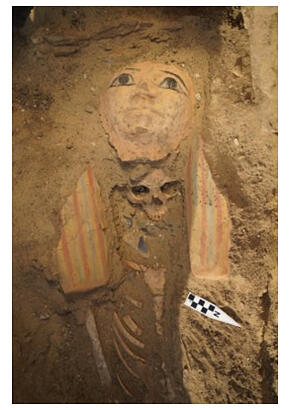Nozomu Kawai, Professor at the Institute for Frontier Science Initiative and the Institute for the Study of Ancient Civilizations and Cultural Resources, Kanazawa University, is the director of the joint mission of the university and the Ministry of Tourism and Antiquities of Egypt. The mission engaged in research between August and September in 2023, finding multiple tombs in the northern part of Saqqara, one of the most important necropolis in Egypt. They discovered tombs from the Second Dynasty of the Early Dynastic Period (c. 2700 BC), the early 18th Dynasty of the New Kingdom Period (c. 1550 BC), the Late Period (7th to 4th century BC), the Ptolemaic Period (c. 4th to 1st century BC), and the Early Roman Period (c. 1st century BC to 2nd century AD).
Since 2017, the mission has been excavating on the eastern escarpment in the northern part of the Saqqara. In 2019, they found a previously unknown catacomb (a mass graveyard), which they dated between the end of the Ptolemaic Period and the Roman Period. When discovered, the catacombs had such brittle bedrock ceilings that they needed reinforcement. In addition, their research was interrupted for about 4 years because of the COVID-19 pandemic. It was not until August 2023 that the researchers were finally able to resume their full-fledged excavation.
Inside the catacombs, several stelae (stone monuments) were found with Greek inscriptions inscribed on them. Furthermore, two cartonnage mummy masks and several terra-cotta figurines of gods were excavated, along with other remains. They also examined the exterior of the catacombs. There they found the following: a rock grave that had a figure with its limbs flexed inside a wooden coffin, dated to the Second Dynasty; several graves dated to the early 18th Dynasty; a buried figure with a mummy mask, dated to the Late Period; a tomb made of mud-bricks, dated to the Ptolemaic Period; a buried mummy dated to the Roman Period; and more.
Their excavation sites, which are in areas where no archaeological excavations had been conducted to date, demonstrated that the eastern slope of the northern Saqqara may contain many graves from several periods in the three millennia starting with the Early Dynastic Period. This excavation project is expected to reveal a more accurate picture of the formation and development of the Saqqara necropolis.
This joint research project was conducted by researchers from Higashi Nippon International University, Waseda University, Kindai University, National Museum of Nature and Science, Tokyo Metropolitan University, Tokyo Denki University, Tokyo University of the Arts, Meiji University, Tokyo National Research Institute for Cultural Properties, the American University in Cairo, and Yale University.

(C) North Saqqara Project, Kanazawa University
This article has been translated by JST with permission from The Science News Ltd. (https://sci-news.co.jp/). Unauthorized reproduction of the article and photographs is prohibited.




